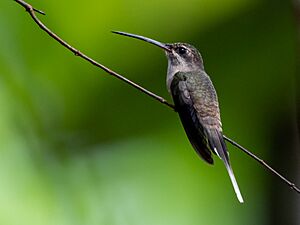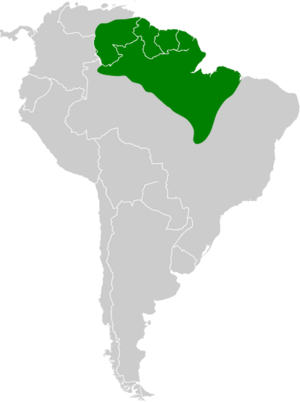Long-tailed hermit facts for kids
Quick facts for kids Long-tailed hermit |
|
|---|---|
 |
|
| Conservation status | |
| Scientific classification | |
| Genus: |
Phaethornis
|
| Species: |
superciliosus
|
 |
|
| Synonyms | |
|
Trochilus superciliosus Linnaeus, 1766 |
|
The long-tailed hermit (Phaethornis superciliosus) is a fascinating hummingbird known for its long tail. These birds live in parts of South America, including Venezuela, the Guianas, and north-eastern Brazil. They are called "resident breeders" because they live and raise their young in these areas all year round.
Contents
About the Long-Tailed Hermit
Long-tailed hermits are a type of hummingbird that can grow to about 15 centimeters (6 inches) long. They weigh around 6.3 grams (0.22 ounces), which is about the same as a few paper clips!
They have dull brownish-green feathers on their backs. A dark stripe runs through their eyes, with whitish-buff stripes above and below it, like a mask. Their bellies are a pale grayish-buff color. Both male and female long-tailed hermits look similar, but females are usually a bit smaller.
The long-tailed hermit has a very long, curved beak, perfect for reaching nectar deep inside flowers. Its central tail feathers are also very long and have white tips.
Where They Live and What They Eat
Long-tailed hermits prefer to live in the undergrowth of forests, often close to water. They like areas where their favorite food plants grow.
Their main food is nectar, which they sip from large flowers. They especially like flowers from plants like Heliconia, ginger, and passion flower. Besides nectar, they also eat small insects and spiders. These tiny creatures provide important protein for the birds. When baby hummingbirds hatch, the mother feeds them by bringing up (regurgitating) tiny invertebrates.
These hummingbirds are known as "trap-line feeders." This means they don't defend a specific area of flowers. Instead, they fly along a regular route, visiting many different flowers that are in season. These routes can be as long as 1 kilometer (about half a mile) through the forest!
Reproduction and Life Cycle
During the breeding season, male long-tailed hermits gather in special spots called leks. A lek is like a singing club where many males come together. They sing loudly to attract females. Some leks can have dozens of birds!
The males also wiggle their long tails as part of their display. They spend a lot of their daylight hours singing and showing off. The female hummingbird then chooses the male she thinks is the best singer to mate with. Their song sounds like sharp tsuk calls.
Once a female chooses a mate, she is completely responsible for building the nest and raising the young. She builds a cone-shaped nest using plant fibers and spiderwebs. This clever nest is usually hung underneath a large leaf, like a Heliconia or banana leaf. She lays two white eggs in the nest and sits on them to keep them warm until they hatch. After the chicks hatch, she feeds them until they are old enough to fly on their own.
Naming the Long-Tailed Hermit
The long-tailed hermit was first officially described in 1766 by a Swedish scientist named Carl Linnaeus. He gave it the scientific name Trochilus superciliosus. Later, in 1827, another scientist named William Swainson created the genus Phaethornis, and the long-tailed hermit became the main example for this group of hummingbirds.
Scientists recognize two main types, or subspecies, of the long-tailed hermit:
- P. s. superciliosus: Found in southern Venezuela, the Guianas, and northern Brazil (north of the Amazon River).
- P. s. muelleri: Found in northern Brazil (south of the Amazon River).
The names of these birds can sometimes be a bit confusing! For a while, this bird was called the "eastern long-tailed hermit" to tell it apart from a similar bird in the west. But now, scientists have changed the names of those other birds, so this one is simply called the long-tailed hermit again.


